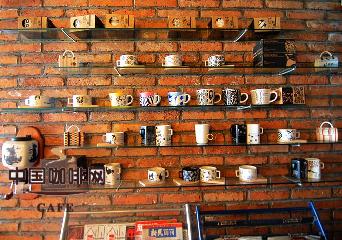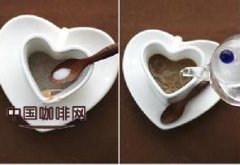Technical terms in coffee shops Coffee tasting terms

Complexity (Complexity)
Refers to the different levels of characteristics that coexist in the same cup of coffee, with high complexity, indicating that there are many kinds of sensory stimuli that can be felt; it should be noted that these feelings include the aftertaste and are not necessarily limited to the present feeling when drinking.
Texture, taste (Body, Mouthfeel)
Refers to the thick and slippery touch of coffee in the mouth, which is approximately proportional to the amount of colloid suspension in coffee. Since the texture is felt throughout the mouth, we use "rich" to describe thick coffee, while vice versa, we use "thin". Thin coffee tastes like wine or lemonade, while rich coffee tastes like full-fat fresh milk or syrup.
Acidity (sour)
Wonderful acidity is the reason why some coffees are highly valued. In fact, all coffee has acidity, because raw beans contain a lot of chloric acid, and in the process of roasting, these chloric acid will be transformed into a variety of aromatic or irritating acids, but these acids will scorch at high temperatures, making the more deeply roasted beans are less sour.
If the brewing temperature is too low, or excessive extraction, the tannic acid, nicotinic acid and so on in the coffee will enter the mouth and stimulate the underside of the tongue, accompanied by a pungent smell. This is different from delicious acid, which stimulates the edges of both sides of the tongue and inspires adjectives such as "thin" and "sharp", while soft acid feels evenly near the middle part of the tongue in addition to both sides of the tongue. make some soft acid close to salty taste (such as tomato and plum acid) or soda feeling.
Bitter taste (Bitter)
This is the characteristic of deep-baked beans, the feeling of the whole mouth and throat, not just the tongue; it is the most influential taste ingredient that dominates the color and taste of coffee. The sugar, starch and fiber in raw coffee beans will be caramelized due to the heat of roasting, and the substances released in this change will make the color of coffee a unique amber color and produce a unique bitter taste.
Sweet (Sweet)
There are two meanings. The first is the stimulation of sugar on the tip of the tongue, which is generally called sweetness; the other means that in the process of deep roasting, it is reminiscent of syrup because of part of the astringent substance and rich taste of glycol; the tip of the tongue does not have to react.
Balance (Balance)
There are complex and rich features, but none of them are particularly prominent.
Barista (barista)
It refers to the person who stands behind the Starbucks counter and knows every perfect concentrated drink recipe. He can interpret your needs and make the drinks you really want.
Shot (one espresso)
One ounce of espresso. Each standard espresso consists of three parts: rich gold foam (crema), mellow taste (body) and warm heart (heart). Gold foam refers to the caramel-colored foam on the surface of espresso, which disappears a few seconds after the espresso is brewed.
Espresso (espresso) (E-SPRE'-SO)
Use the mellow coffee extracted from our concentrated roasted coffee beans. Espresso is usually served in a small coffee cup and is often used to blend other unique coffee drinks.
Espresso Con Pana (E-SPRE'-SO CONE PA'-NA) (concentrated Campbell Blue)
The espresso is covered with smooth whipped cream.
Espresso Macchiato (E-SPRE'-SO MA-KEE-AH'-TOE) (concentrated macchiato)
Espresso is gently marked with foam.
Caffe Latte (KA-FAY' LA'-TAY) (Nati)
A three-stage, smooth-tasting drink: a fresh espresso, filled with hot milk, and then covered with a thin layer of milk foam to create an amazing taste. Latte Macchiato is made in much the same way as Natti, except that macchiato must first add milk and then add coffee to "mark" it to make it taste smoother (Macchiato), which means "marking" in Italian.
Caffe Mocha (KA-FAY' MO'-KAH) (Mocha)
A classic combination of mellow espresso and high-quality chocolate, mixed with fresh hot milk and topped with smooth whipped cream.
Cappuccino (KA-PU-CHEE'-NO) (cappuccino)
A typical Italian breakfast drink with less milk and more bubbles than Latte. Generally speaking, "dry" (dry) refers to cappuccino with more milk foam, while "wet" (wet) refers to cappuccino with more milk.
Caffe Americano (KA-FAY' A-MER-I-CAH'-NO) (American coffee)
The combination of mellow espresso and hot water creates a drink with a full flavor and a deep taste of espresso.
Single (single espresso)
An espresso (about 1 ounce) extracted from an espresso machine, usually served alone or steamed with mellow hot milk. Most small and medium drinks contain an espresso.
Double (double espresso)
Two single espressos are standard for Starbucks large drinks, but if you want your medium natty to be stronger, you can tell the service staff to add an extra espresso for you.
Short (small cup)
In Starbucks,Short, it refers to an 8-ounce drink that is most suitable for drinking after dinner.
Tall (medium cup)
Tall refers to a 12-ounce drink, which is the most frequently ordered Size.
Grande (large cup)
In Starbucks,Grande, it refers to a 16-ounce drink, which is your best choice when you want to reward yourself.
Low-fat (low fat)
For a more burden-free option, you can choose low-fat milk to make your own low-fat natty.
No foam (no foam)
Don't you like the milk foam on the embankment on your nose? You can tell the service staff that you don't want foam, so you'll only get a combination of espresso and hot milk.
Dry (those with more milk foam)
It means that there are more bubbles than milk. If you like cappuccino full of sweet milk foam, you can tell the service staff what you need.
With room (leave some space)
I'd like to add some milk to my American coffee / daily coffee, please make some room for me.
Whip (fresh cream)
Whipped cream
The acronym of. If you want to reduce the calories of mocha coffee, you can tell the service staff, "I don't want whipped cream" (no whip).
Vanilla (vanilla syrup), Hazelnut (hazelnut syrup),... Etc.
Important Notice :
前街咖啡 FrontStreet Coffee has moved to new addredd:
FrontStreet Coffee Address: 315,Donghua East Road,GuangZhou
Tel:020 38364473
- Prev

Two common types of coffee: roasted coffee and instant coffee
There are two main kinds of coffee we drink: one is roasted coffee (coffee beans), the other is instant coffee. Roasted coffee: raw coffee beans are roasted and then ground into powder, and the coffee is extracted into liquid for us to drink in different ways. What needs to be emphasized here is that freshly roasted coffee beans must be drunk. Instant coffee: different processing methods are divided into two types, one is
- Next

Why is the Espresso authentic espresso so small?
Why the authentic espresso ultra-small cup as an Italian who has lived in Guangzhou for five years, Romeo is very happy to have a more satisfying espresso in Guangzhou. As a local Italian, the Touch bar in Pearl River New Town is also the foothold of the International Coffee Taste College, in addition to all manual pull-rod coffee machines and excellent baristas.
Related
- Beginners will see the "Coffee pull flower" guide!
- What is the difference between ice blog purified milk and ordinary milk coffee?
- Why is the Philippines the largest producer of crops in Liberia?
- For coffee extraction, should the fine powder be retained?
- How does extracted espresso fill pressed powder? How much strength does it take to press the powder?
- How to make jasmine cold extract coffee? Is the jasmine + latte good?
- Will this little toy really make the coffee taste better? How does Lily Drip affect coffee extraction?
- Will the action of slapping the filter cup also affect coffee extraction?
- What's the difference between powder-to-water ratio and powder-to-liquid ratio?
- What is the Ethiopian local species? What does it have to do with Heirloom native species?

